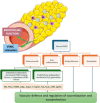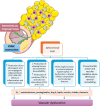Perivascular adipose tissue: a central player in the triad of diabetes, obesity, and cardiovascular health
- PMID: 39732729
- PMCID: PMC11682657
- DOI: 10.1186/s12933-024-02549-9
Perivascular adipose tissue: a central player in the triad of diabetes, obesity, and cardiovascular health
Abstract
Perivascular adipose tissue (PVAT) is a dynamic tissue that affects vascular function and cardiovascular health. The connection between PVAT, the immune system, obesity, and vascular disease is complex and plays a pivotal role in the pathogenesis of vascular diseases such as atherosclerosis, hypertension, and vascular inflammation. In cardiometabolic diseases, PVAT becomes a significant source of proflammatory adipokines, leading to increased infiltration of immune cells, in cardiometabolic diseases, PVAT becomes a significant source of proinflammatory adipokines, leading to increased infiltration of immune cells, promoting vascular smooth muscle cell proliferation and migrationpromoting vascular smooth muscle cell proliferation and migration. This exacerbates vascular dysfunction by impairing endothelial cell function and promoting endothelial activation. Dysregulated PVAT also contributes to hemodynamic alterations and hypertension through enhanced sympathetic nervous system activity and impaired vasodilatory capacity of PVAT-derived factors. Therapeutic interventions targeting key components of this interaction, such as modulating PVAT inflammation, restoring adipokine balance, and attenuating immune cell activation, hold promise for mitigating obesity-related vascular complications. Lifestyle interventions, pharmacological agents targeting inflammatory pathways, and surgical approaches aimed at reducing PVAT mass or improving adipose tissue function are potential therapeutic avenues for managing vascular diseases associated with obesity and PVAT dysfunction.
Keywords: Cardiovascular disease; Inflammation; Obesity; Perivascular adipose tissue; Therapeutic interventions; Type 2 diabetes.
© 2024. The Author(s).
Conflict of interest statement
Declarations. Ethical approval: Not applicable. Consent for publication: Not applicable. Competing interests: The authors declare no competing interests.
Figures



Similar articles
-
The influence of perivascular adipose tissue on vascular homeostasis.Vasc Health Risk Manag. 2013;9:105-16. doi: 10.2147/VHRM.S33760. Epub 2013 Mar 28. Vasc Health Risk Manag. 2013. PMID: 23576873 Free PMC article. Review.
-
Endothelial and Perivascular Adipose Tissue Abnormalities in Obesity-Related Vascular Dysfunction: Novel Targets for Treatment.J Cardiovasc Pharmacol. 2017 Jun;69(6):360-368. doi: 10.1097/FJC.0000000000000469. J Cardiovasc Pharmacol. 2017. PMID: 28141700 Review.
-
Mechanistic Links Between Obesity, Diabetes, and Blood Pressure: Role of Perivascular Adipose Tissue.Physiol Rev. 2019 Oct 1;99(4):1701-1763. doi: 10.1152/physrev.00034.2018. Physiol Rev. 2019. PMID: 31339053 Review.
-
Perivascular adipose tissue (PVAT) in atherosclerosis: a double-edged sword.Cardiovasc Diabetol. 2018 Oct 10;17(1):134. doi: 10.1186/s12933-018-0777-x. Cardiovasc Diabetol. 2018. PMID: 30305178 Free PMC article. Review.
-
Emerging Roles of Sympathetic Nerves and Inflammation in Perivascular Adipose Tissue.Cardiovasc Drugs Ther. 2019 Apr;33(2):245-259. doi: 10.1007/s10557-019-06862-4. Cardiovasc Drugs Ther. 2019. PMID: 30747398 Free PMC article. Review.
Cited by
-
Sex-Specific Characteristics of Perivascular Fat in Aortic Aneurysms.J Clin Med. 2025 Apr 29;14(9):3071. doi: 10.3390/jcm14093071. J Clin Med. 2025. PMID: 40364103 Free PMC article. Review.
-
Achilles' Heel of Aortic Aneurysms: Adipose-Myofibroblast Differentiation.Circ Res. 2025 Jun 20;137(1):23-25. doi: 10.1161/CIRCRESAHA.125.326726. Epub 2025 Jun 19. Circ Res. 2025. PMID: 40536941 No abstract available.
-
From Liking to Following: The Role of Food Preferences, Taste Perception, and Lifestyle Factors in Adherence to the Mediterranean Diet Among Young Individuals.Nutrients. 2025 Feb 6;17(3):600. doi: 10.3390/nu17030600. Nutrients. 2025. PMID: 39940456 Free PMC article.
-
Advances and challenges of targeting epicardial adipose tissue (EAT) and perivascular adipose tissue (PVAT).Cardiovasc Diabetol. 2025 Aug 4;24(1):319. doi: 10.1186/s12933-025-02763-z. Cardiovasc Diabetol. 2025. PMID: 40760703 Free PMC article. Review.
-
C-C chemokine ligand 5 from women subcutaneous adipose tissue has a central role in vascular aging.Cardiovasc Diabetol. 2025 Jul 18;24(1):295. doi: 10.1186/s12933-025-02815-4. Cardiovasc Diabetol. 2025. PMID: 40682056 Free PMC article.
References
-
- Wang Z, Lu H, Garcia-Barrio M, Guo Y, Zhang J, Chen YE, Chang L. RNA sequencing reveals perivascular adipose tissue plasticity in response to angiotensin II. Pharmacol Res. 2022;178:106183. - PubMed
Publication types
MeSH terms
Substances
Grants and funding
LinkOut - more resources
Full Text Sources
Medical

